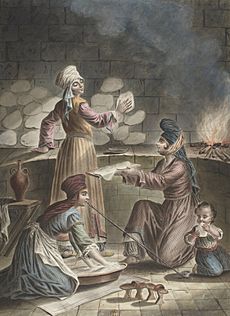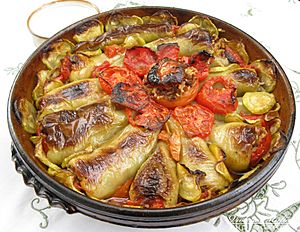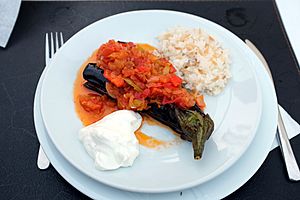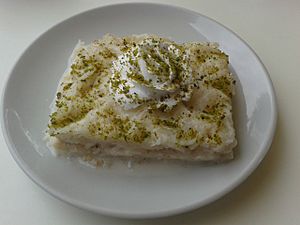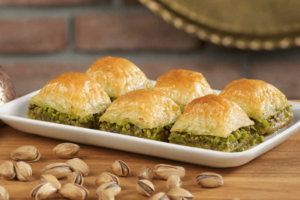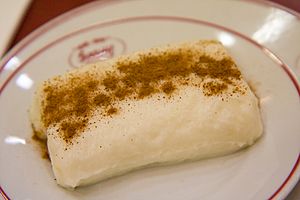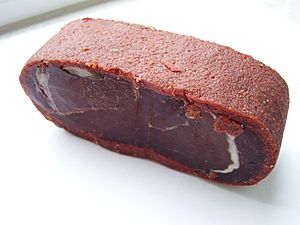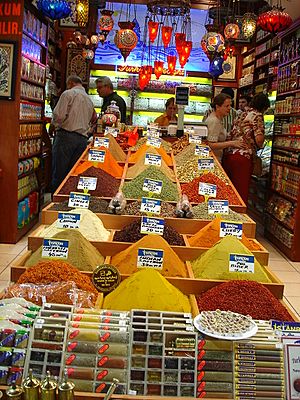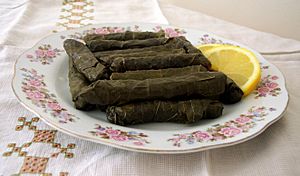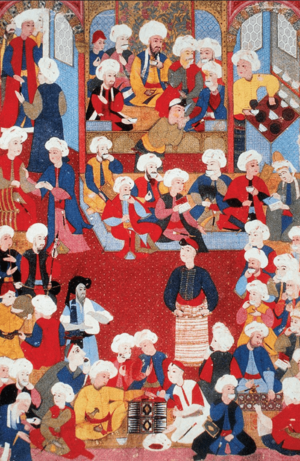Ottoman cuisine facts for kids
Ottoman cuisine is the delicious food and cooking style of the Ottoman Empire, a huge empire that lasted for many centuries. Today, you can still find its influence in the foods of Turkey, the Balkans, the Middle East, and North Africa. Many popular dishes from these regions have their roots in Ottoman cooking!
Contents
History of Ottoman Food
How Ottoman Cuisine Grew
Ottoman food is a mix of many different cooking traditions. It combines ideas from Central Asia, Persia, the Balkans, Arab countries, and the Byzantine Empire. Imagine a giant melting pot of flavors! New spices and ingredients also arrived during the Columbian Exchange, which was when new foods from the Americas came to Europe and Asia.
The early Turkic tribes, who later formed the Ottoman Empire, were already influenced by Persian cooking. For example, Ayran, a yogurt drink, is thought to come from their Central Asian heritage. Many dishes, like pilaf (rice dishes), show how different cultures shared and enriched each other's food.
New Foods Arrive
Trade routes helped bring exciting new ingredients into the Ottoman Empire. This made their food even more special and unique. For instance, Fernand Braudel noted that the Ottomans introduced rice, sesame, and corn to the region.
Tomatoes, which came from the Americas, started appearing in Ottoman cooking by the late 1600s. Cookbooks from the 1800s, like Ayşe Fahriye's Ev Kadını, even had recipes for green and red tomatoes. Dishes like tomato pilaf and stuffed tomatoes (dolma) are still popular in Turkish cuisine today. Other new foods from the Americas included potatoes, beans, peppers, pumpkins, and zucchini.
How Ottoman Food Spread
The amazing food from the Ottoman palaces didn't just stay with the sultans! Ottoman officials and travelers helped spread these dishes to different parts of the empire.
Ottoman food also influenced Europe starting in the 1500s. For example, sharbat (a sweet drink) became popular in Italy. Rice pudding, called "Turkish-style rice" back then, was served at fancy weddings. Even a sweet treat similar to nougat, called koz halva, spread to Central Europe. In Hungary, they called it 'Turkish honey'!
What Makes Ottoman Food Special?
The Ottoman Empire was huge, covering many different climates and places. This meant its cuisine was incredibly diverse. It included not only the fancy food from the Sultan's Palace but also many unique dishes from different regions.
Böreks and Pastries
Börek is a famous Ottoman pastry, often filled with cheese, meat, or vegetables. It might be related to similar pastries from Persia. The word "börek" itself has a long history, appearing in old Chinese and Turkish cookbooks.
In the 1800s, at Ottoman banquets, börek was sometimes served alongside French pastries. Another special pastry is boyoz, which came to the empire with Sephardic Jews in 1492. Today, it's mainly found in Izmir, showing the rich cultural mix of the region.
Bread in Ottoman Times
Bread was a very important food. It was made from wheat, and its quality depended on the flour. Istanbul, the capital, needed a lot of grain, so it was brought in from many different areas.
The palace kitchens baked many kinds of bread:
- Fodula: A flat white bread.
- Somun: Loaves of good quality whole wheat bread.
- Fırancala: White bread.
- Yufka: Thin filo pastry sheets.
Adding seeds like sesame or spices like cloves made bread a luxury. Less expensive options included porridges like lapa and keşkek.
Sweet Desserts
In the 1600s, sugar was very expensive. So, people often used honey or fruit syrups like pekmez (made from grapes) to sweeten their desserts.
Aşure, a wheat berry pudding, is a very old dish. Its roots go back to ancient harvest celebrations.
Baklava, a famous layered pastry with nuts and syrup, has many theories about where it came from. Some say it's from ancient Roman times, others from Persia or Central Asia. Another milky layered dessert, güllaç, is similar.
Zerde was a rice pudding cooked with honey and saffron, often decorated with almonds and fruit. Muhallebi was another popular milk pudding.
Interestingly, Europeans visiting the Ottoman Empire noticed that sweet dishes were often served between other courses, not just at the end of the meal like in Europe!
Dolma: Stuffed Delights
Dolma means "stuffed." These dishes were made by stuffing whole fruits and vegetables, or by wrapping leaves (like vine leaves) around a filling. The filling could be minced meat or spiced rice.
One traveler described stuffed pumpkins and eggplants with mutton and garlic, served with yogurt. Another dolma dish, sarma, used vine leaves cooked with sour plums.
Popular Drinks
Coffeehouses first started in the Ottoman Empire and then spread across Europe. In the 1700s, Istanbul had many coffeehouses, sharbat shops, and bozahanes (places selling boza).
Boza is a thick, slightly fermented drink made from millet. It was a very popular public drink in the 1400s and 1500s before coffeehouses became more common.
Fish Dishes
The fish markets in Ottoman cities were amazing! In the 1600s, the market in Galata (Istanbul) was described as having "large quantities of fish of all varieties."
Anchovies were a favorite, especially in the coastal city of Trabzon. One old travel book describes a delicious anchovy dish cooked in a pan with cinnamon, black pepper, leeks, celery, parsley, and onions, all drizzled with olive oil.
Fruits, Nuts & Seeds
The palace records show many different fruits and nuts were enjoyed. Pomegranates came from areas around the Sea of Marmara. Oranges arrived in the 1700s, and tangerines even later. Tropical fruits like bananas were not mentioned in old records.
Fruits were used to make sharbat (sweet drinks) and compotes (stewed fruits). Since sugar was expensive, these were often sweetened with dried fruits, molasses, or honey. Hundreds of shops in 1600s Istanbul specialized in hoşaf, an Ottoman-style compote often eaten at the end of a meal.
Meat Dishes
Kebabs, mantı (dumplings), köfte (meatballs), pastırma (cured beef), and yahni (stews) are all types of meat dishes from Ottoman cuisine. Old writings describe shish kebab on skewers and meat slow-cooked in special ovens called tandoor.
Ottoman kebabs were often slow-cooked in earthenware pots or tandoor ovens. A recipe from the 1600s describes roasting meat, then boiling it with beef or chicken juices, and serving it with olive oil and a little sugar.
Stuffed roasted lamb with rice and raisins was a fancy dish served at special events for the Sultan's family and Istanbul's wealthy people. Hunting for food was also common, with rabbits being a very popular game animal.
Rice Pilaf
Rice was mostly imported from Egypt and used to make pilaf. These rice dishes were called dane in Ottoman Turkish, a word from Persian. For the wealthy, rice dishes were rich and varied, made with mulberries, stir-fried meats, honey, pomegranates, and gourds. Festive pilaf platters were often made even richer with almonds, pistachios, and currants.
Soups and Stews
Çorba (soup) was a common dish. Many 16th-century Ottoman soups started with a base of chicken stock and rice, with different vegetables added. Lamb stock was also used. Garlicky işkembe çorbası (tripe soup) was sold early in the morning.
Soups could be thickened with egg and flour or bread, and a sour ingredient like lemon juice. This style of soup was found in Turkey and Balkan countries. Hand-cut soup noodles called erişte were also a basic dish, similar to those in Central Asian cooking.
Spices: The Flavor Makers
When the Ottomans took Constantinople in 1453, they gained control of the spice trade in the eastern Mediterranean. Spices were used in many ways, including in health tonics made by the palace chefs. These tonics could have up to 60 different spices!
Melons were sometimes seasoned with cinnamon and cloves. Fancy bread was perfumed with aniseed. Street vendors sold warm milk drinks sprinkled with cinnamon or ginger. Fish stews often included cinnamon, and kebabs could be spiced with cumin.
Some reports from the 1600s say that spices were used moderately, mostly black pepper. However, others said Ottomans used "a great deal of rich spice," making the food very flavorful.
Sweet and Sour Dishes
Sweet and sour flavors were common in classical Ottoman cooking. Old writings mention using lots of figs, apricots, raisins, and dates in sour dishes.
The sweet and sour lamb dish mutancana is said to have been one of Sultan Mehmed II's favorite meals. Another notable sweet and sour dish was Mahmudiyye, made with chicken and noodles.
Vegetables in Ottoman Meals
Palace records from the late 1400s show that carrots, cucumbers, eggplants, parsley, spinach, and chard were bought regularly. Leeks were a staple food, especially for Jewish communities in Thessaloniki who faced economic hardship.
Braising (slow cooking in liquid) was a typical way to cook vegetables in the 1800s, sometimes with lamb. By the 1880s, printed recipes started adding tomatoes to braised dishes. Vegetables were also widely used for stuffing in dolma.
Pickles
Pickled cabbage was a common preparation. One traveler noted that while Turks had cabbage, they preferred to pickle it rather than cook it with beef like Hungarians. Pickled cabbage was known even in Byzantine times.
Palace Cuisine: Food for the Sultan
Behind the Palace Kitchens
The Topkapı Palace was the heart of classical Ottoman palace cuisine for 400 years. It was a huge place, hosting up to 4,000 people at a time, with a massive kitchen staff. For one event in the 1700s, over 1,000 chefs were needed to cook for 10,000 soldiers!
Chefs from all over the empire were brought to the Imperial Palace kitchens. They were chosen for their skill, often tested by how well they could cook a simple rice dish. Their job was to experiment with new ingredients and create new dishes.
All food for the Sultan was first tasted by the chesnidjibashi, the imperial food taster, to check for poison and taste. The amazing dishes created in the palace kitchens also influenced the food eaten by ordinary people, especially during events like Ramadan.
Clarified butter was the favorite cooking fat in the palace, used for rice dishes, sweet pastries, and savory börek. Olive oil was mainly used for lamps and soap, but also for dishes like stuffed vegetables (dolma), İmam bayıldı, and Karnıyarık. Sweets like majun, compote, and halva were also made by palace chefs.
17th Century Palace Food
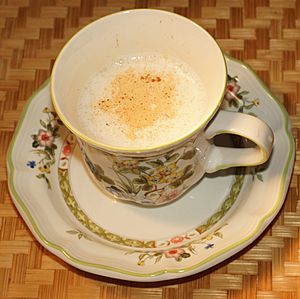
A palace record from 1692 lists many vegetables eaten: squash, celery, lettuce, cucumber, garlic, eggplants, spinach, turnips, and vine leaves. Herbs like parsley, dill, mint, and tarragon were also used. Green tomatoes were listed for the hasseki sultan (the Sultan's favorite). She also received snow for iced coffee and to cool sharbat. Chicken was for the elite, and pigeon only for the Sultan and his closest family. Salep, a drink made from orchid tubers, was also popular.
18th Century Palace Food
Pepper and cinnamon were the most used spices in the 18th-century Ottoman court. They were used in huge amounts! Black pepper was very popular in almost all Ottoman dishes.
19th Century Palace Food
Mutton, clarified butter, flour, and rice were the most common ingredients in the 19th-century palace. Butter and yogurt came from Egyptian and Dutch cows. Popular cheeses included kaşar, kaşkaval, tulum peyniri, and beyaz peynir. Spices like cinnamon, clove, saffron, cumin, and black pepper were common.
More fish, roe, and caviar were eaten than in earlier centuries, including pickled bonito called lakerda. Offal meats (like tripe and liver) were more common than lamb, which was a luxury. Beef was mainly used for pastırma and sucuk.
Güllaç, a starch-based dessert, was made during Ramadan.
Banquets in the 19th century mixed Ottoman and French dishes. For example, at a celebration in 1856, savory börek, pilaf, kadayıf, and baklava were served alongside new French-named creations.
Special Palace Dishes
- Roasted pigeon
- Ayva dolma and kalye (vegetables or fruits cooked without meat, with olive oil and tomato paste)
- Kavun dolması (stuffed melon)
- Piyaziye
Imam Bayıldı
Imam bayıldı is a famous eggplant dish with a fun legend behind its name (it means "the imam fainted"!). It was created in the imperial kitchens and is still a popular dish in modern Turkish cuisine.
Public Kitchens: Food for Everyone
The Ottoman Empire had public kitchens, called imaret, that provided food for travelers and the poor.
Hebron's Public Kitchen
In Hebron, there was a tradition called the "Table of Abraham" (simat al-Khalil). It offered food to travelers. In the 15th and 16th centuries, guests received a bowl of lentils with olive oil, bread, and raisins. On Thursday evenings, pomegranate seeds and seasoned rice were served. Everyone was welcome. One traveler in the 1600s described the "soup of Abraham" as incredibly tasty.
Jerusalem's Public Kitchen
At the Haseki Sultan Imaret in Jerusalem, guests received two bowls of soup daily. These soups were rich with clarified butter, legumes, grains, and seasonal vegetables, always served with bread. On Fridays and special holidays, lamb and rice were served instead of soup, along with zerde (rice pudding with honey and saffron).
Istanbul's Public Kitchens
In Istanbul, travelers could get basic meals for three days at the imaret in Fatih. Guests staying at the roadside inns (caravansarai) also received special bread, honey, and sweets upon arrival. Two soups were served daily: rice soup in the mornings and wheat soup in the evenings, often with meat and fresh parsley. The Friday menu included lamb with rice, zerde, and zırbaç (a dessert with dried fruits and nuts). High-ranking guests ate lamb and rice every day. The kitchens baked 3,300 loaves of bread daily, and leftovers were given to the poor.
Food Words: A Mix of Languages
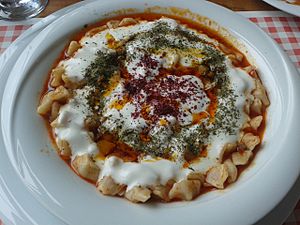
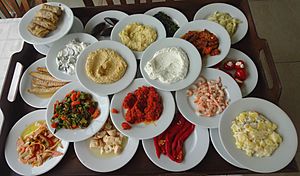
The words used for food in Ottoman Turkish came from many languages, especially Persian.
Other food words came from Italian (like barbunya for beans), Greek (fasulye for beans), Chinese (manti for dumplings), and Arabic (muhallebi for pudding).
In the 1800s, the Ottomans started using French cooking terms at fancy events. French cuisine was seen as the best in the world. So, banquet menus for international guests were written in French, and French serving styles were adopted. However, Ottoman pilaf, börek, and kebabs were still proudly served. Food was a way to show Ottoman power, and using French styles showed they were just as cultured as Europeans.
Here are some examples of French and Turkish food terms from early 20th-century palace menus:
| French | Turkish | English |
|---|---|---|
| Consommé | Et suyu | Meat stock |
| Consommé à la Reine | Et suyu | Meat stock (Chicken soup thickened with tapioca) |
| Consommé de volaille glacé | Soğuk tavuk suyu | Cold chicken soup |
| Créme de fruits | Kaymaklı meyve tatlısı | Fruits with whipped cream |
| Fraises voilées | Kaymaklı çilek | Strawberries with whipped cream |
| Gâteux aux fruits | Meyveli pasta | Fruitcake |
| Gâteux aux amandes | Bademli pasta | Almond cake |
| Gâteux Marquise | Çikolata tatlısı | Chocolate Marquise cake |
| Gâteux panaché | Yemişli bademli pasta | Ice-cream cake with fruits |
| Dessert | Şekerleme (candies) | Dessert |
| Gaufrettes Sultanié | Kaymaklı yaprak tatlısı | Sultan's waffles |
| Glace | Dondurma | Ice cream |
| Glace aveline | Dondurma | (Hazelnut) ice cream |
| Granité glacé aux fraises | Çilekli dondurma | Strawberry sorbet |
| Mont Blanc | Mont Blanc pastry | |
| Neige d'Ananas | Ananaslı dondurma | Pineapple sorbet |
| Tarte à la Chambord | Şambor tatlısı | Chambord dessert tart |
| Vacherin Chantilly | Kremalı tatlı | Meringue dessert |
Ottoman Food's Lasting Impact
Even after the Ottoman Empire ended, its cooking style lived on in many places like Turkey, the Balkans, and Greece. Foods from Hungary, Albania, Greece, Romania, Serbia, Bulgaria, and Bosnia all share this Ottoman food heritage. It's sometimes hard to tell exactly where a dish first came from because so many cultures shared and influenced each other over centuries.
When the Ottoman Empire broke apart, new countries were formed. These countries often wanted to create their own unique national identities. Sometimes, this meant trying to forget the shared Ottoman past. But the food traditions remained, showing how deeply connected these cultures truly are. Many national cuisines today still have strong local and regional traditions from the Ottoman era.
See also
 In Spanish: Gastronomía del Imperio otomano para niños
In Spanish: Gastronomía del Imperio otomano para niños



